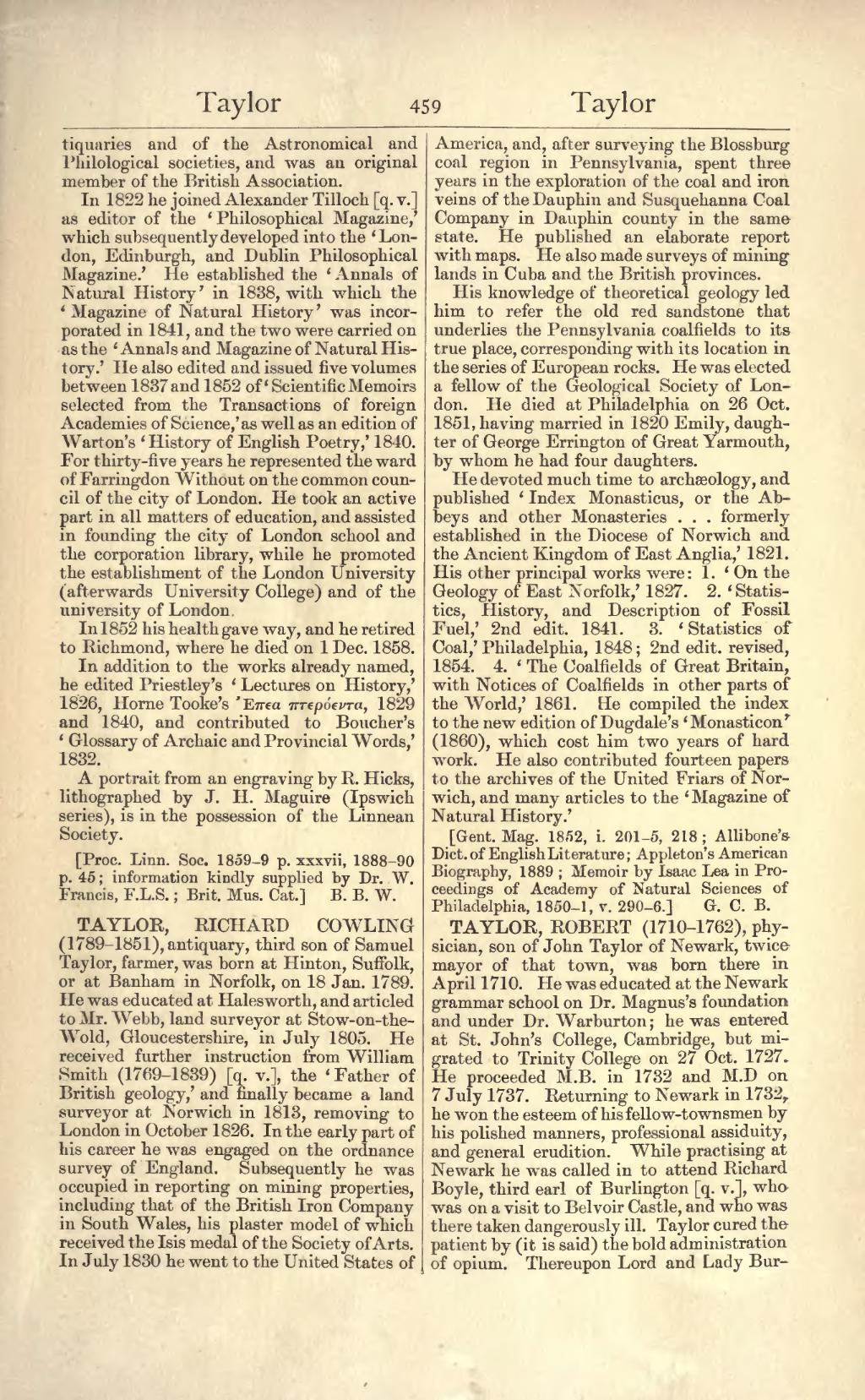tiquaries and of the Astronomical and Philological societies, and was an original member of the British Association.
In 1822 he joined Alexander Tilloch [q. v.] as editor of the ‘Philosophical Magazine,’ which subsequently developed into the ‘London, Edinburgh, and Dublin Philosophical Magazine.’ He established the ‘Annals of Natural History’ in 1838, with which the ‘Magazine of Natural History’ was incorporated in 1841, and the two were carried on as the ‘Annals and Magazine of Natural History.’ He also edited and issued five volumes between 1837 and 1852 of ‘Scientific Memoirs selected from the Transactions of foreign Academies of Science,’ as well as an edition of Warton's ‘History of English Poetry,’ 1840. For thirty-five years he represented the ward of Farringdon Without on the common council of the city of London. He took an active part in all matters of education, and assisted in founding the city of London school and the corporation library, while he promoted the establishment of the London University (afterwards University College) and of the university of London.
In 1852 his health gave way, and he retired to Richmond, where he died on 1 Dec. 1858.
In addition to the works already named, he edited Priestley's ‘Lectures on History,’ 1826, Horne Tooke's Ἐπεα πτερόεντα, 1829 and 1840, and contributed to Boucher's ‘Glossary of Archaic and Provincial Words,’ 1832.
A portrait from an engraving by R. Hicks, lithographed by J. H. Maguire (Ipswich series), is in the possession of the Linnean Society.
[Proc. Linn. Soc. 1859–9 p. xxxvii, 1888–90 p. 45; information kindly supplied by Dr. W. Francis, F.L.S.; Brit. Mus. Cat.]
TAYLOR, RICHARD COWLING (1789–1851), antiquary, third son of Samuel Taylor, farmer, was born at Hinton, Suffolk, or at Banham in Norfolk, on 18 Jan. 1789. He was educated at Halesworth, and articled to Mr. Webb, land surveyor at Stow-on-the-Wold, Gloucestershire, in July 1805. He received further instruction from William Smith (1769–1839) [q. v.], the ‘Father of British geology,’ and finally became a land surveyor at Norwich in 1813, removing to London in October 1826. In the early part of his career he was engaged on the ordnance survey of England. Subsequently he was occupied in reporting on mining properties, including that of the British Iron Company in South Wales, his plaster model of which received the Isis medal of the Society of Arts. In July 1830 he went to the United States of America, and, after surveying the Blossburg coal region in Pennsylvania, spent three years in the exploration of the coal and iron veins of the Dauphin and Susquehanna Coal Company in Dauphin county in the same state. He published an elaborate report with maps. He also made surveys of mining lands in Cuba and the British provinces.
His knowledge of theoretical geology led him to refer the old red sandstone that underlies the Pennsylvania coalfields to its true place, corresponding with its location in the series of European rocks. He was elected a fellow of the Geological Society of London. He died at Philadelphia on 26 Oct. 1851, having married in 1820 Emily, daughter of George Errington of Great Yarmouth, by whom he had four daughters. He devoted much time to archæology, and published ‘Index Monasticus, or the Abbeys and other Monasteries … formerly established in the Diocese of Norwich and the Ancient Kingdom of East Anglia,’ 1821. His other principal works were:
- ‘On the Geology of East Norfolk,’ 1827.
- ‘Statistics, History, and Description of Fossil Fuel,’ 2nd edit. 1841.
- ‘Statistics of Coal,’ Philadelphia, 1848; 2nd edit. revised, 1854.
- ‘The Coalfields of Great Britain, with Notices of Coalfields in other parts of the World,’ 1861.
He compiled the index to the new edition of Dugdale's ‘Monasticon’ (1860), which cost him two years of hard work. He also contributed fourteen papers to the archives of the United Friars of Norwich, and many articles to the ‘Magazine of Natural History.’
[Gent. Mag. 1852, i. 201–5, 218; Allibone's Dict. of English Literature; Appleton's American Biography, 1889; Memoir by Isaac Lea in Proceedings of Academy of Natural Sciences of Philadelphia, 1850–1, v. 290–6.]
TAYLOR, ROBERT (1710–1762), physician, son of John Taylor of Newark, twice mayor of that town, was born there in April 1710. He was educated at the Newark grammar school on Dr. Magnus's foundation and under Dr. Warburton; he was entered at St. John's College, Cambridge, but migrated to Trinity College on 27 Oct. 1727. He proceeded M.B. in 1732 and M.D. on 7 July 1737. Returning to Newark in 1732, he won the esteem of his fellow-townsmen by his polished manners, professional assiduity, and general erudition. While practising at Newark he was called in to attend Richard Boyle, third earl of Burlington [q. v.], who was on a visit to Belvoir Castle, and who was there taken dangerously ill. Taylor cured the patient by (it is said) the bold administration of opium. Thereupon Lord and Lady Bur-
